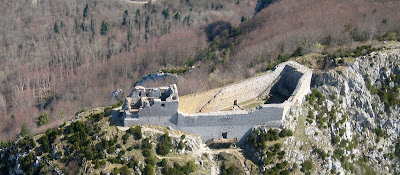Everyone knows about the Templars, or Poor Fellow-Soldiers of Christ and of the Temple of Solomon. Their avowed goal was to protect travelers to the Holy Land. For almost two centuries they offered protection en route to sites in the Holy Land and, as a trustworthy order with members in several countries, became wealthy by being a reliable way to transfer money from one country to another.
Although endorsed by the Church, King Philip IV of France engineered their downfall in France and arrested and tortured a number of them in 1307, confiscating their property in the process. This was very handy for Philip, since he was greatly in financial debt to them. Through use of the Inquisition, they were linked with heresy, accused of consorting with the devil, etc. The Templars' very secret initiation rite made it easy to fabricate lies about what they did.
In 1312, Philip persuaded Pope Clement V to disband the Templars for good, so that no one stood in Philip's way when he executed their Grandmaster, Jacques de Molay. The Templars went out in disgrace for political reasons, vilified for non-Christian practices, after having been one of the most respected groups in Christendom.
The Vatican Secret Archives (Archivum Secretum Apostolicum Vaticanum) contain all the documents of the popes, as opposed to official and public documents. They are "secret" in that they are technically a private library and one cannot simply walk in and check out a book. Popes can give access, however, and recent popes have done so. In 2001, historian and paleographer Barbara Frale discovered a document now known as the Chinon Parchment.
It turns out that Clement wanted to interview the heads of the Order, but their imprisonment and torture made it impossible for them to travel to Avignon to meet him, so he sent his legates to meet with them at Chinon, questioning them about their beliefs. This meeting at Chinon took place in August 1308, as related and notarized in the Chinon Parchment. Even though Clement suppressed the Templars a few years after, due to pressure from Philip, the Chinon Parchment tells us that the pope granted them forgiveness and absolution for their sins and restored to them the right to receive the sacraments.
 |
| The Chinon Parchment |
In 1312, Philip persuaded Pope Clement V to disband the Templars for good, so that no one stood in Philip's way when he executed their Grandmaster, Jacques de Molay. The Templars went out in disgrace for political reasons, vilified for non-Christian practices, after having been one of the most respected groups in Christendom.
The Vatican Secret Archives (Archivum Secretum Apostolicum Vaticanum) contain all the documents of the popes, as opposed to official and public documents. They are "secret" in that they are technically a private library and one cannot simply walk in and check out a book. Popes can give access, however, and recent popes have done so. In 2001, historian and paleographer Barbara Frale discovered a document now known as the Chinon Parchment.
It turns out that Clement wanted to interview the heads of the Order, but their imprisonment and torture made it impossible for them to travel to Avignon to meet him, so he sent his legates to meet with them at Chinon, questioning them about their beliefs. This meeting at Chinon took place in August 1308, as related and notarized in the Chinon Parchment. Even though Clement suppressed the Templars a few years after, due to pressure from Philip, the Chinon Parchment tells us that the pope granted them forgiveness and absolution for their sins and restored to them the right to receive the sacraments.

































